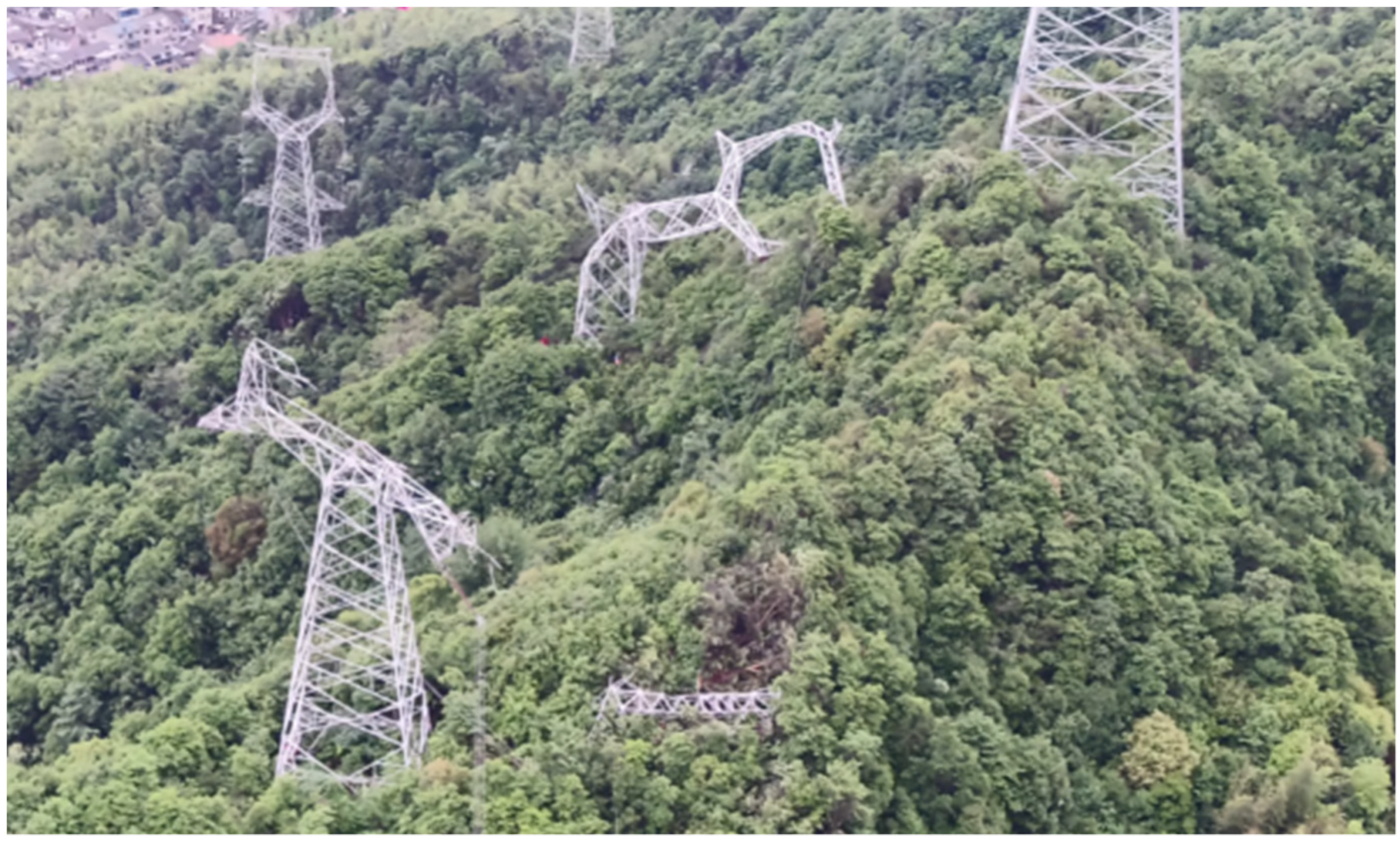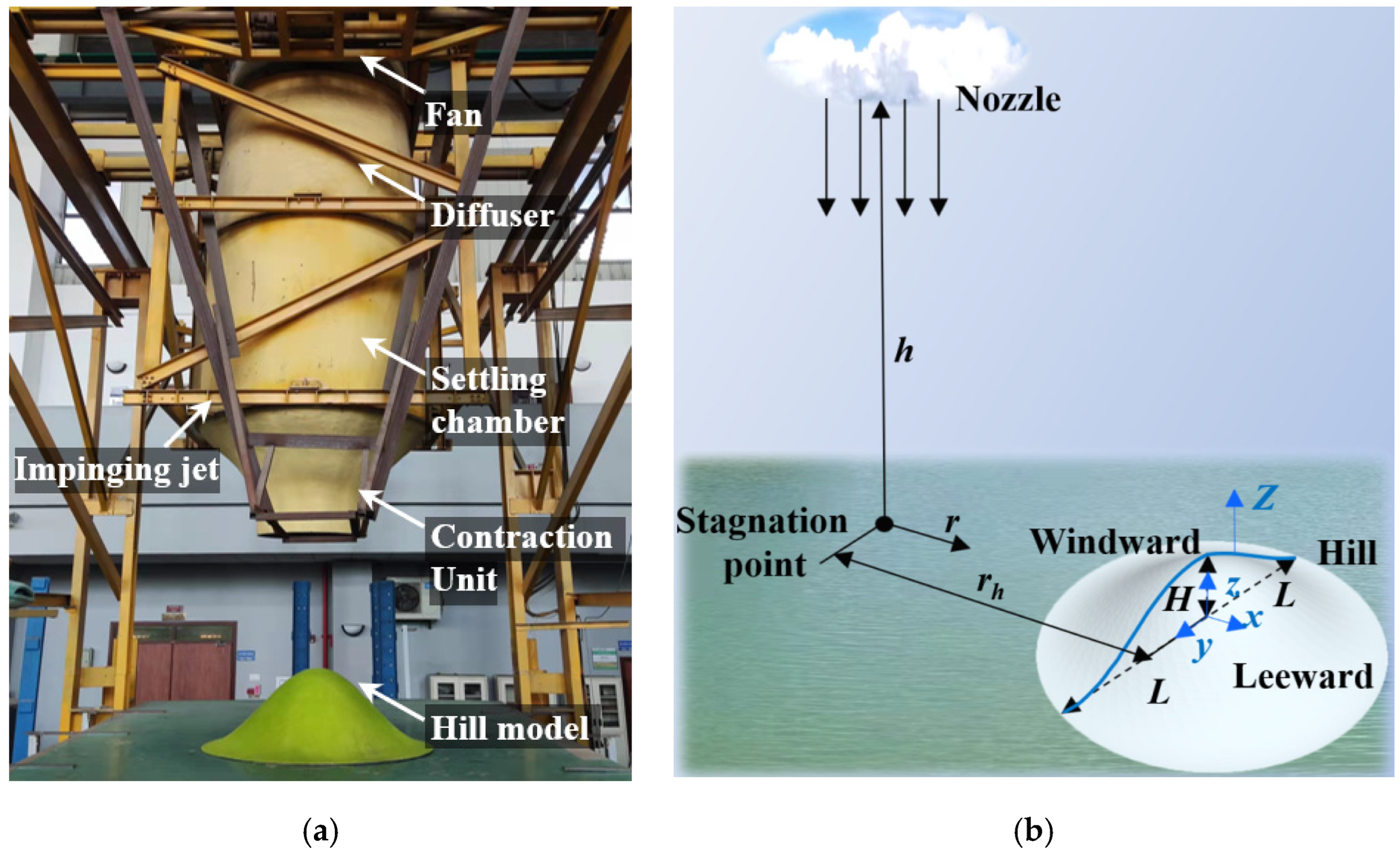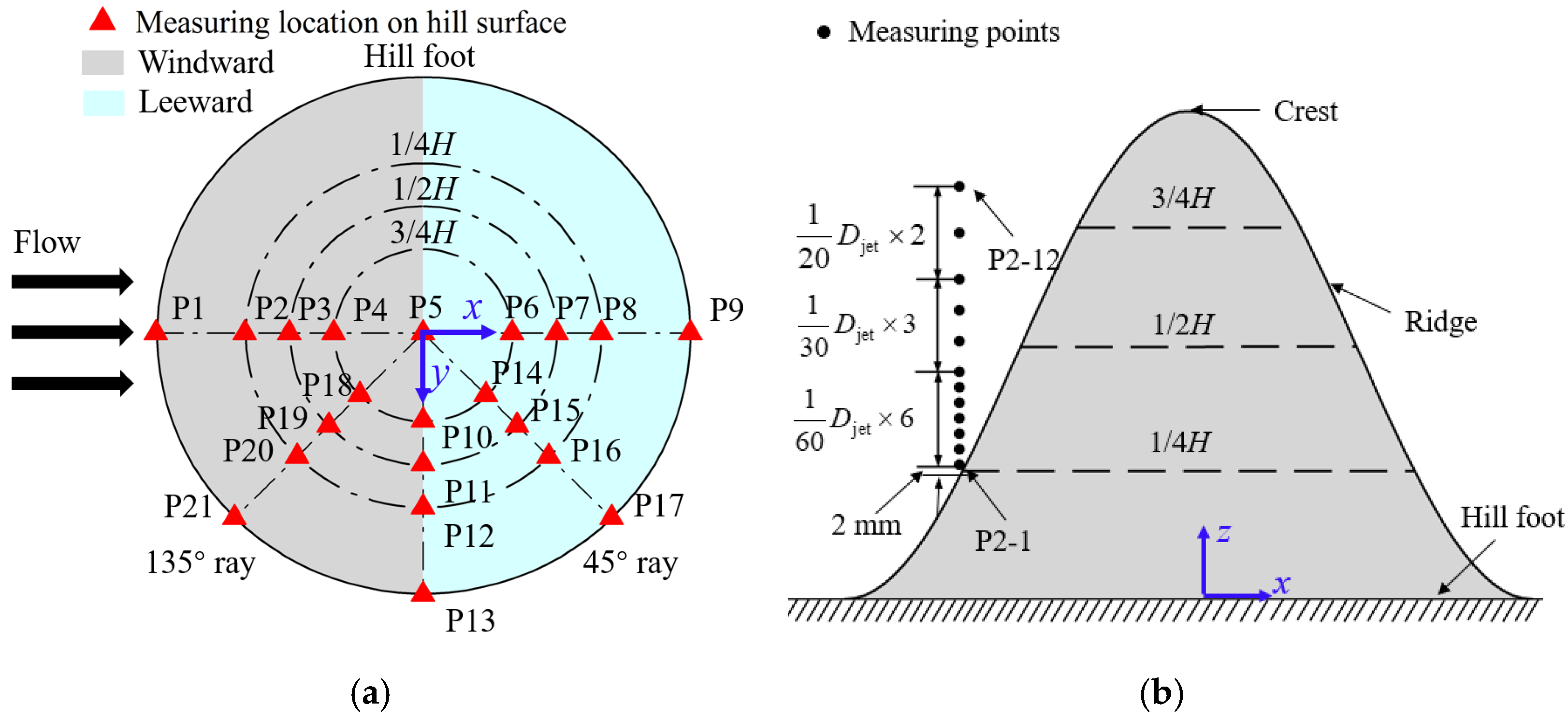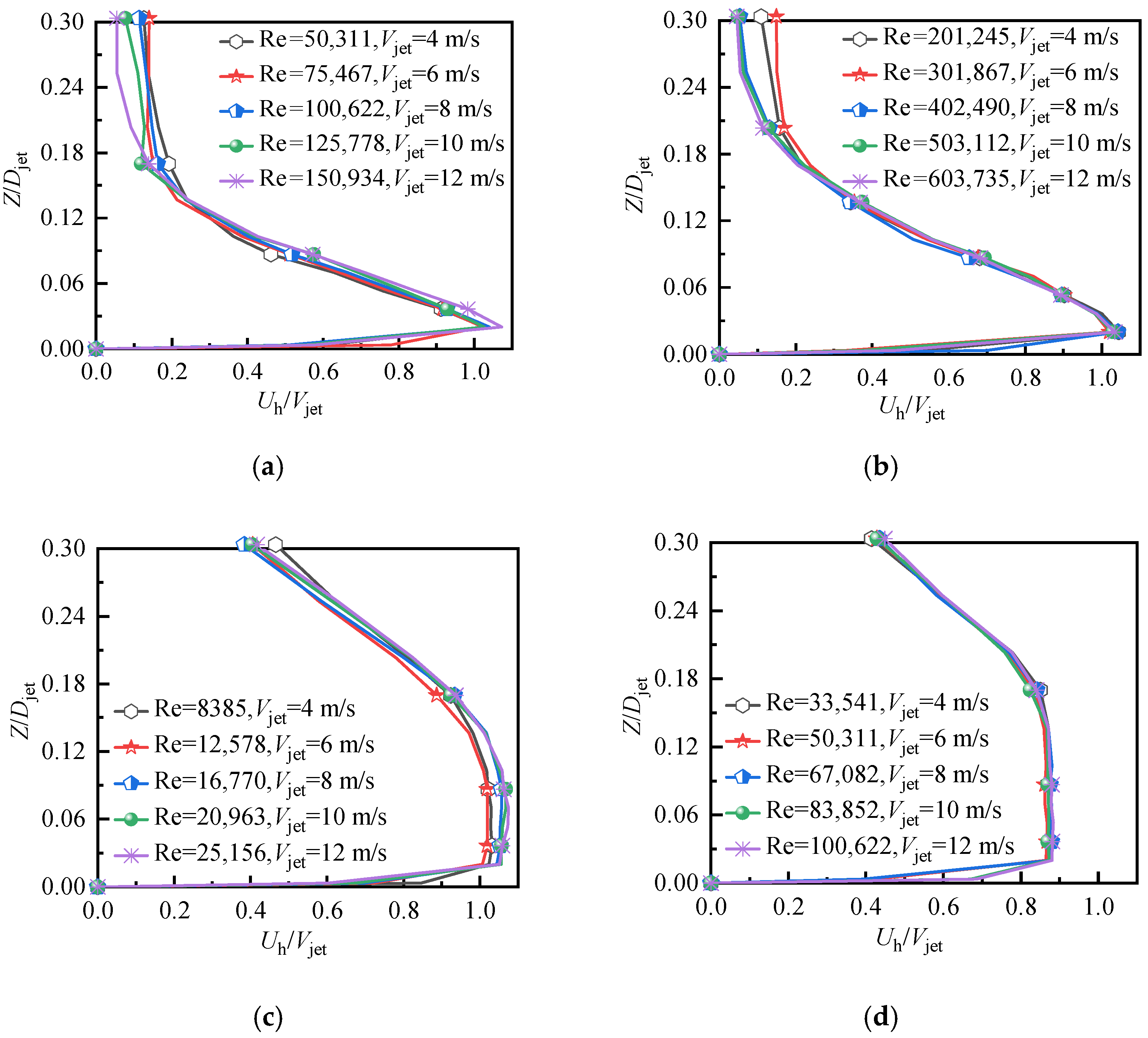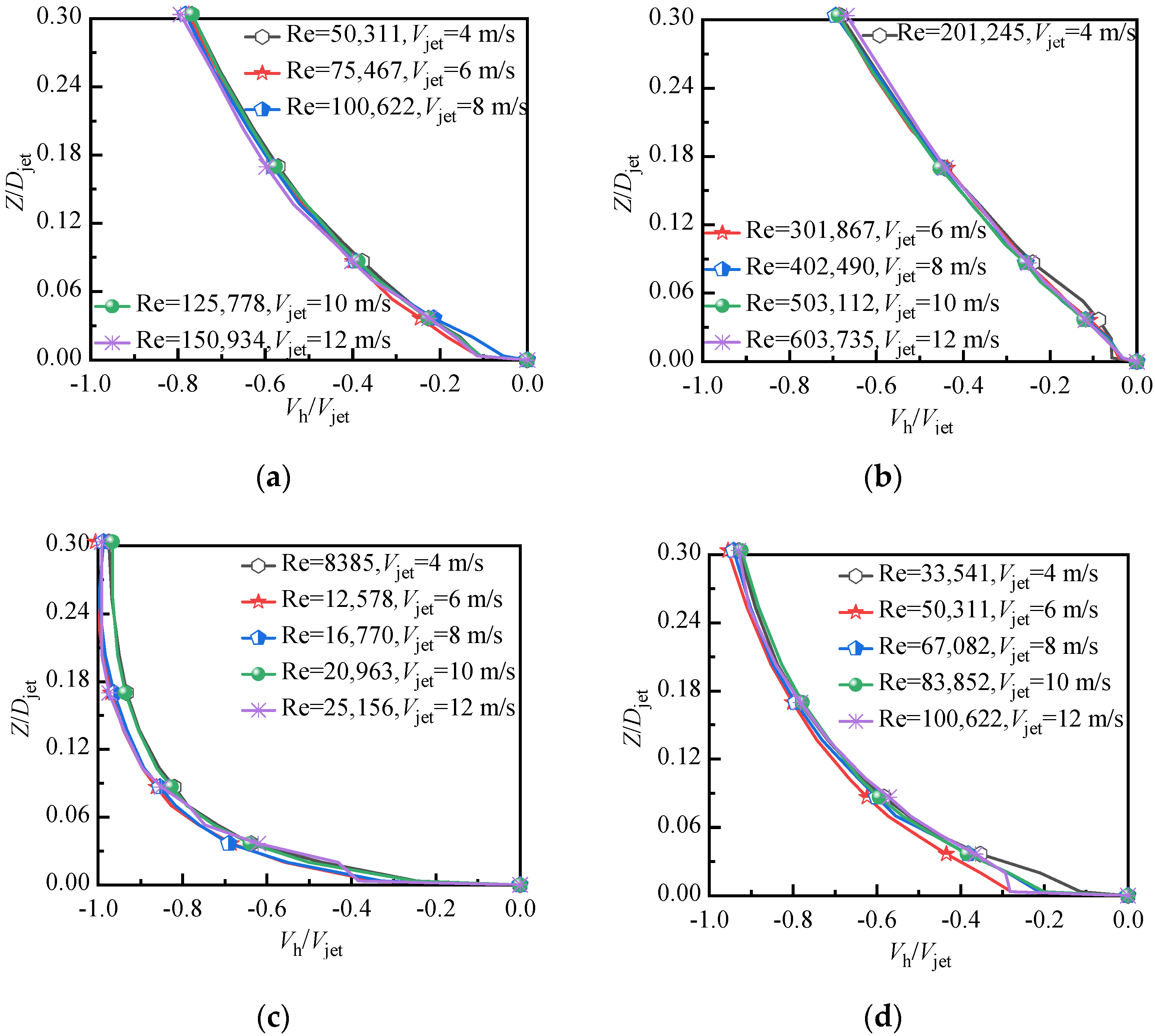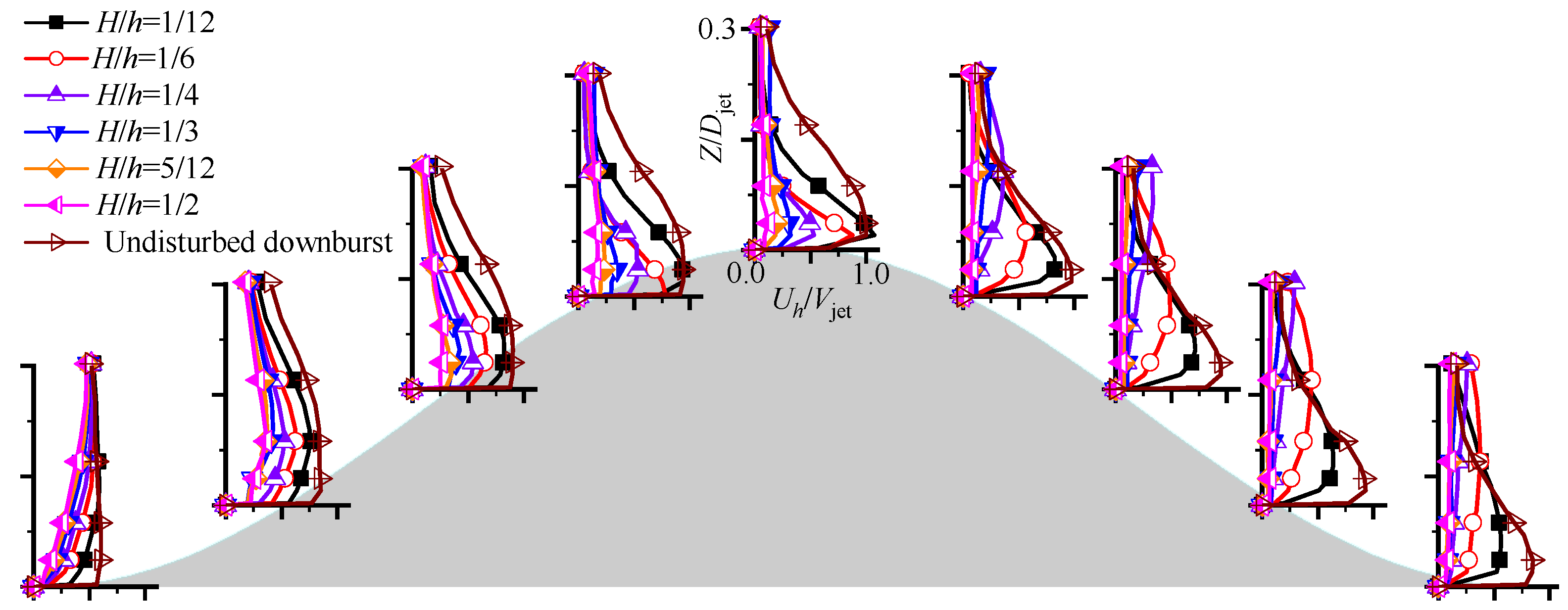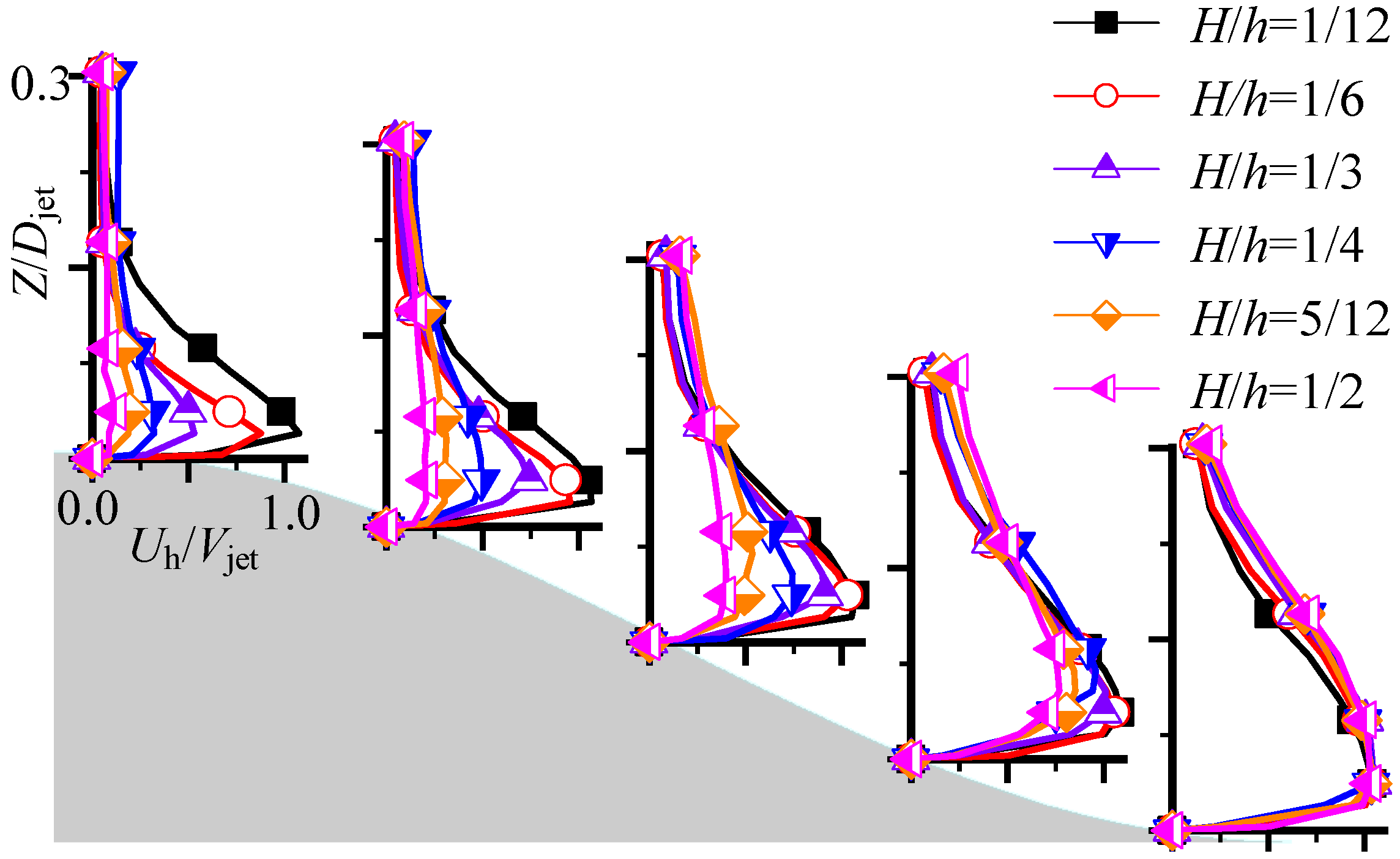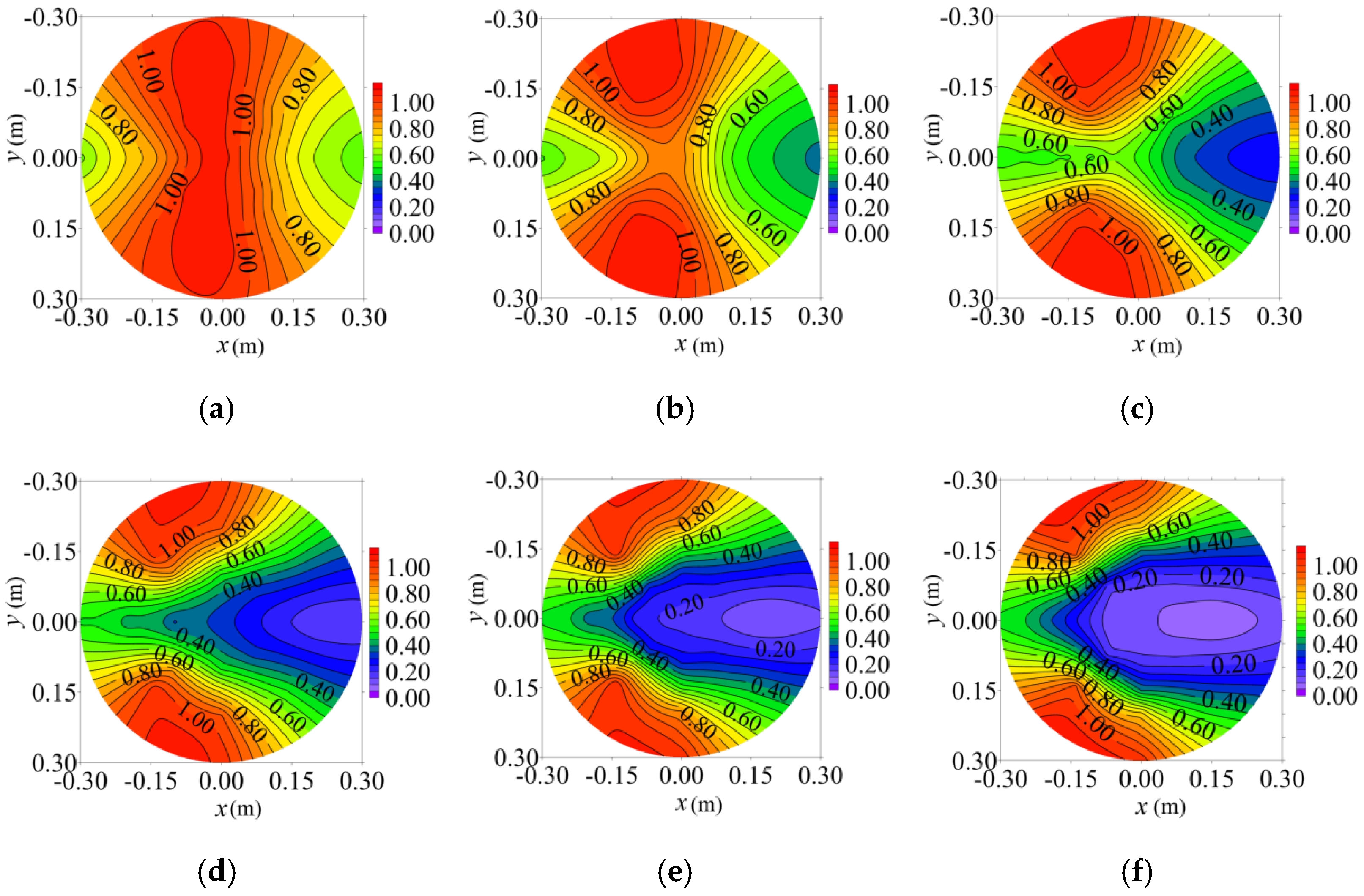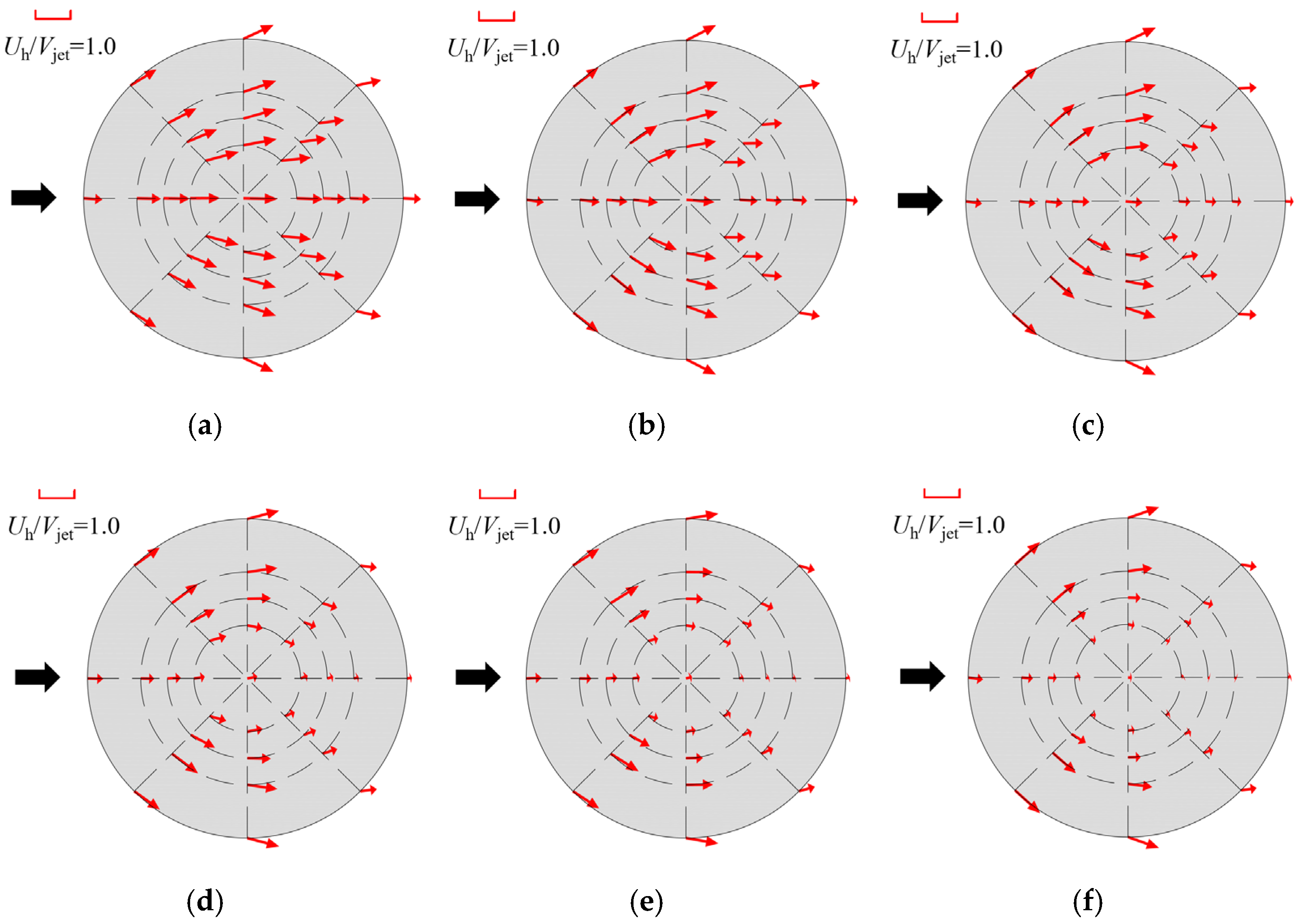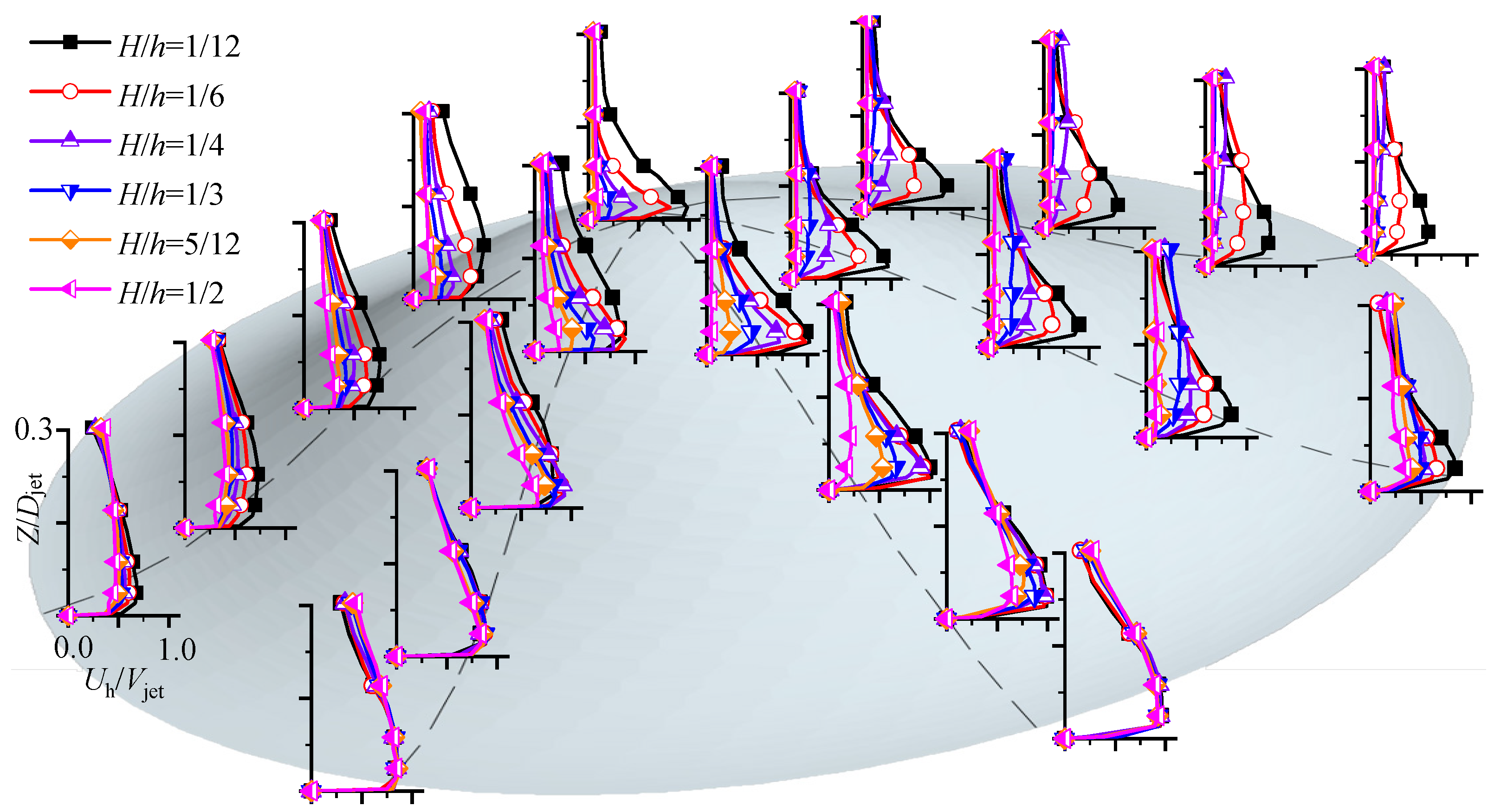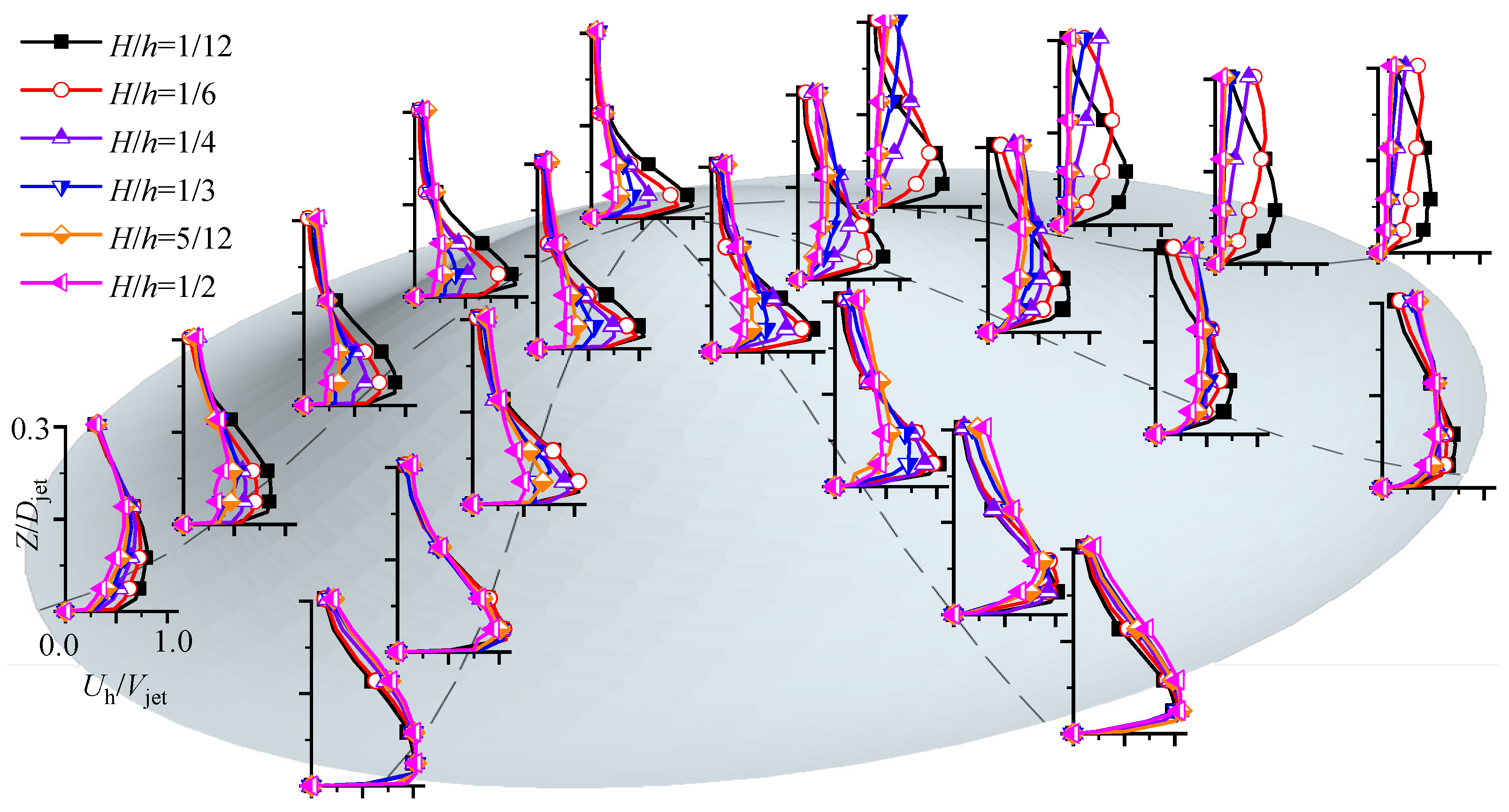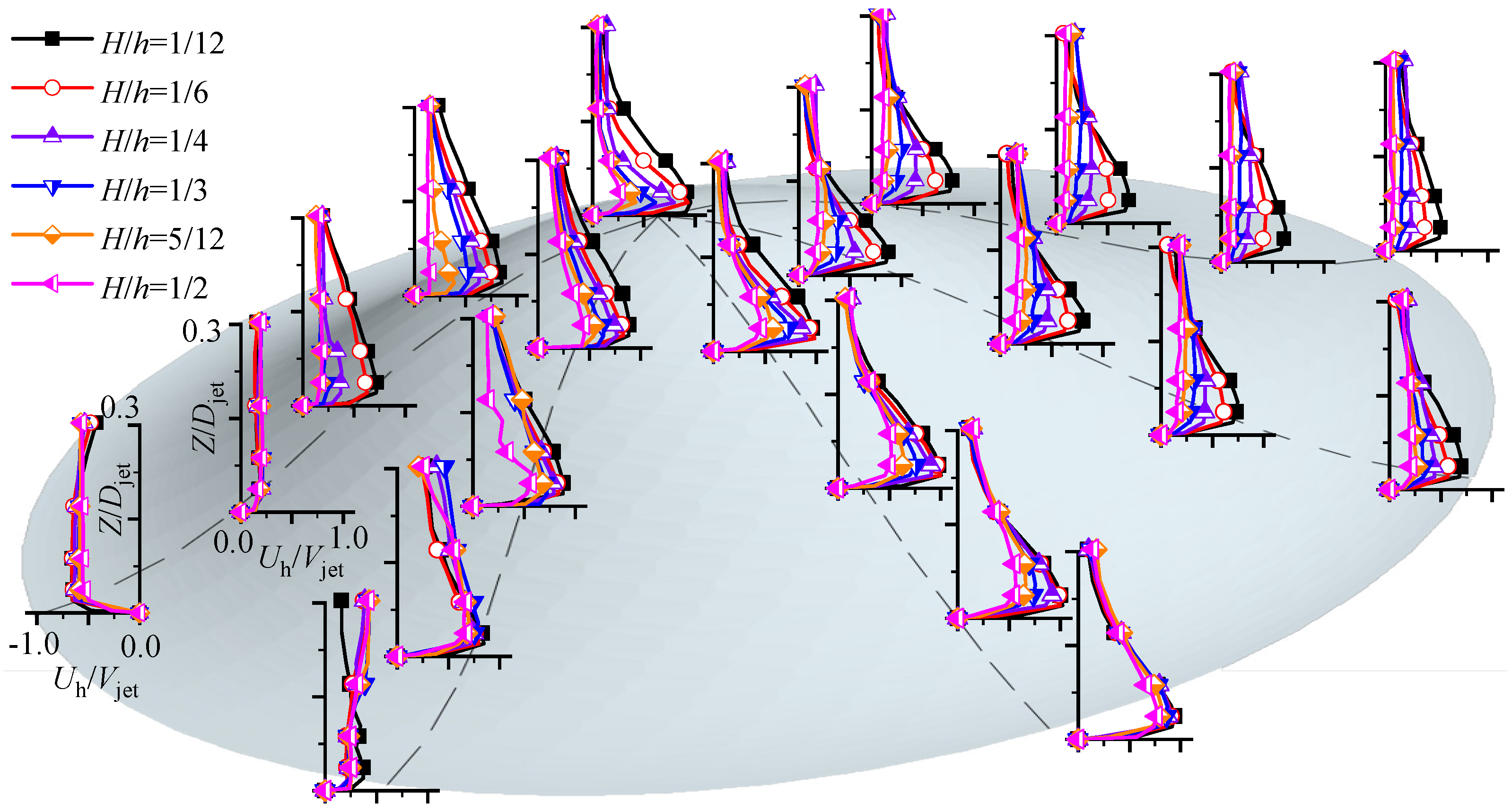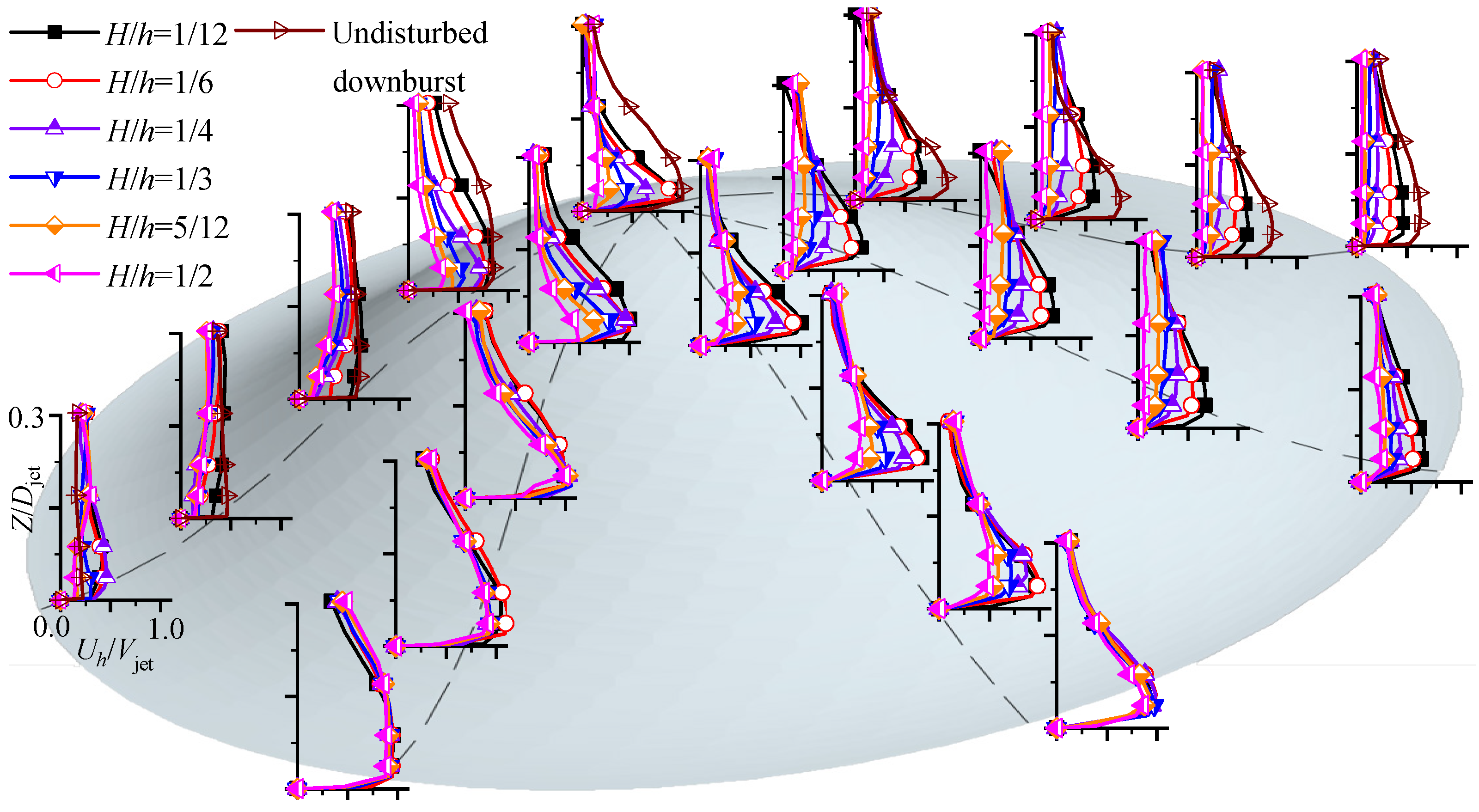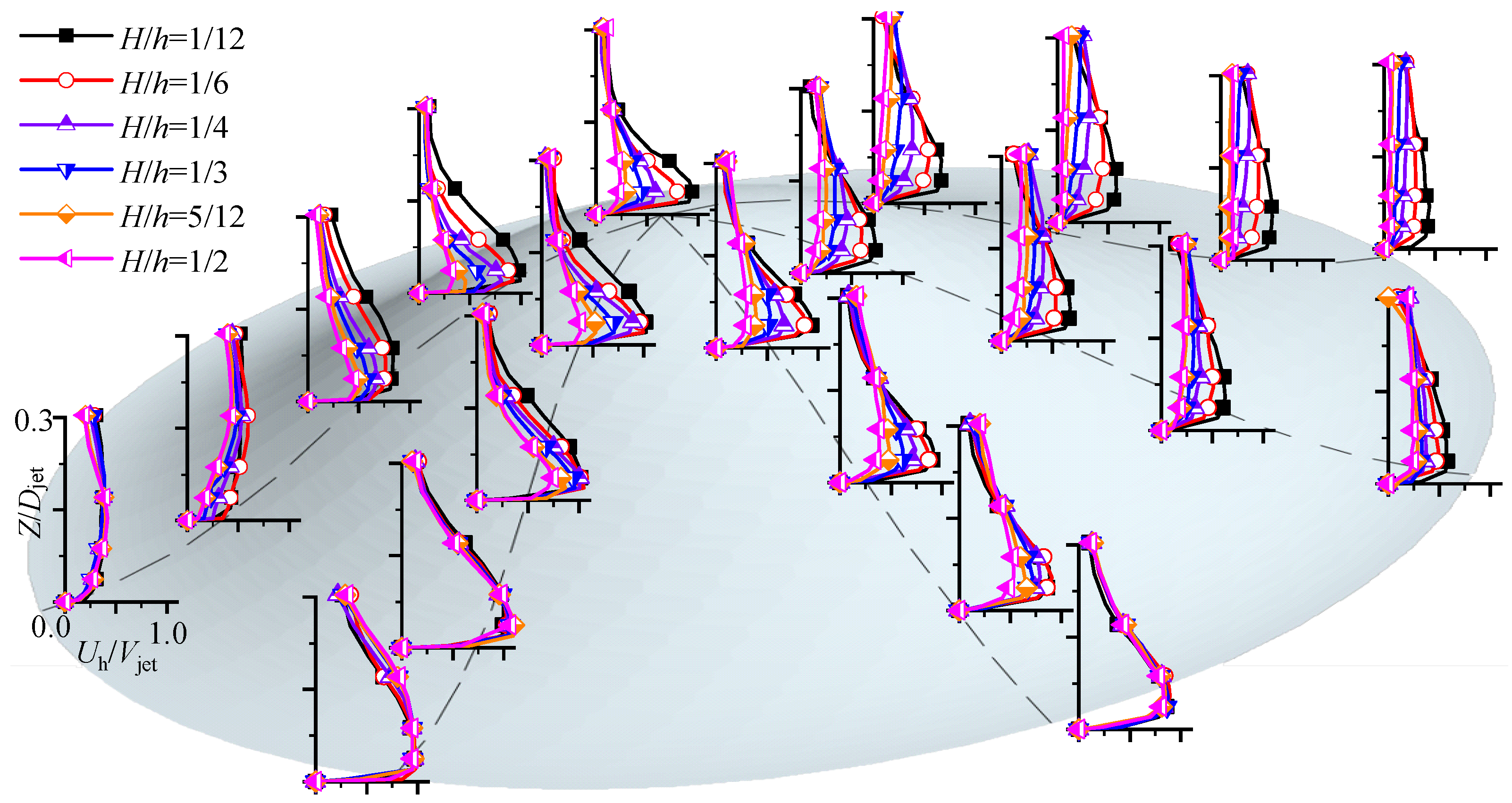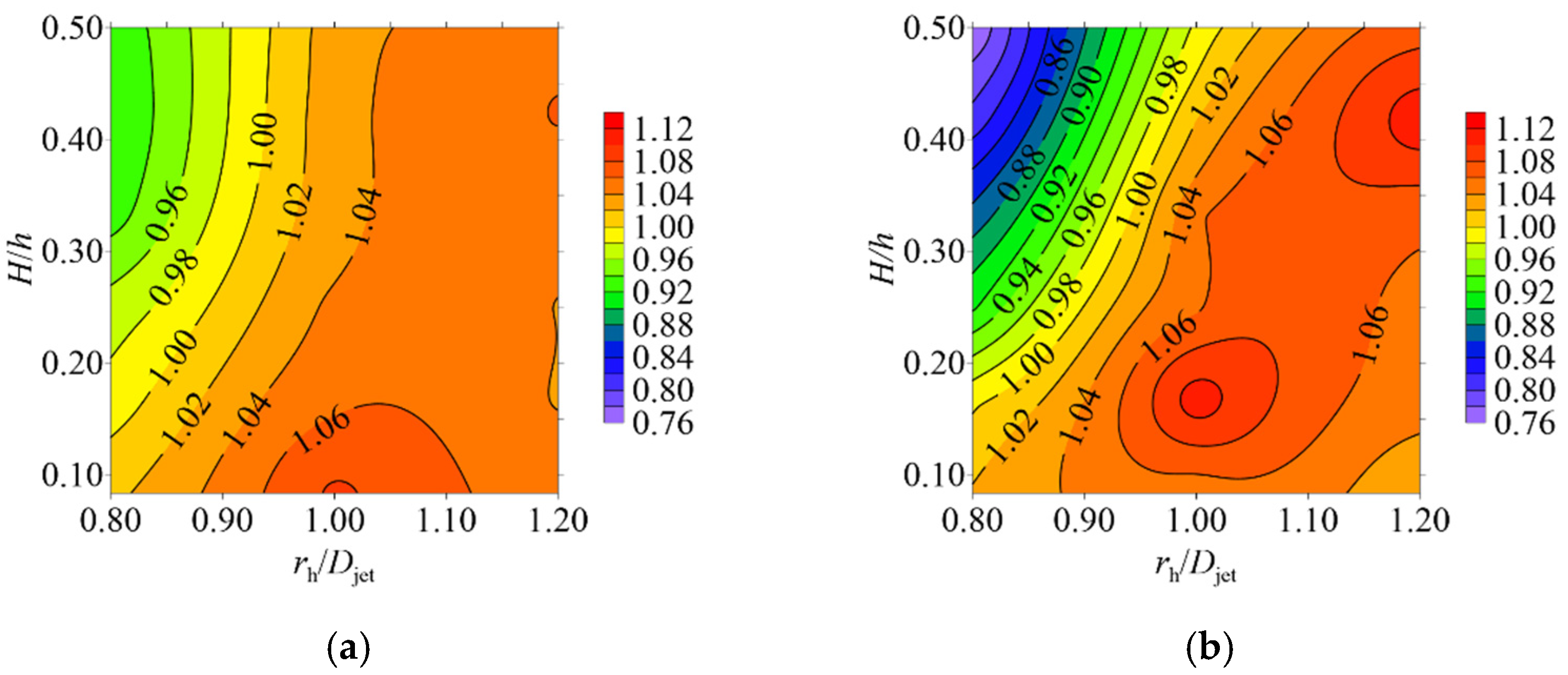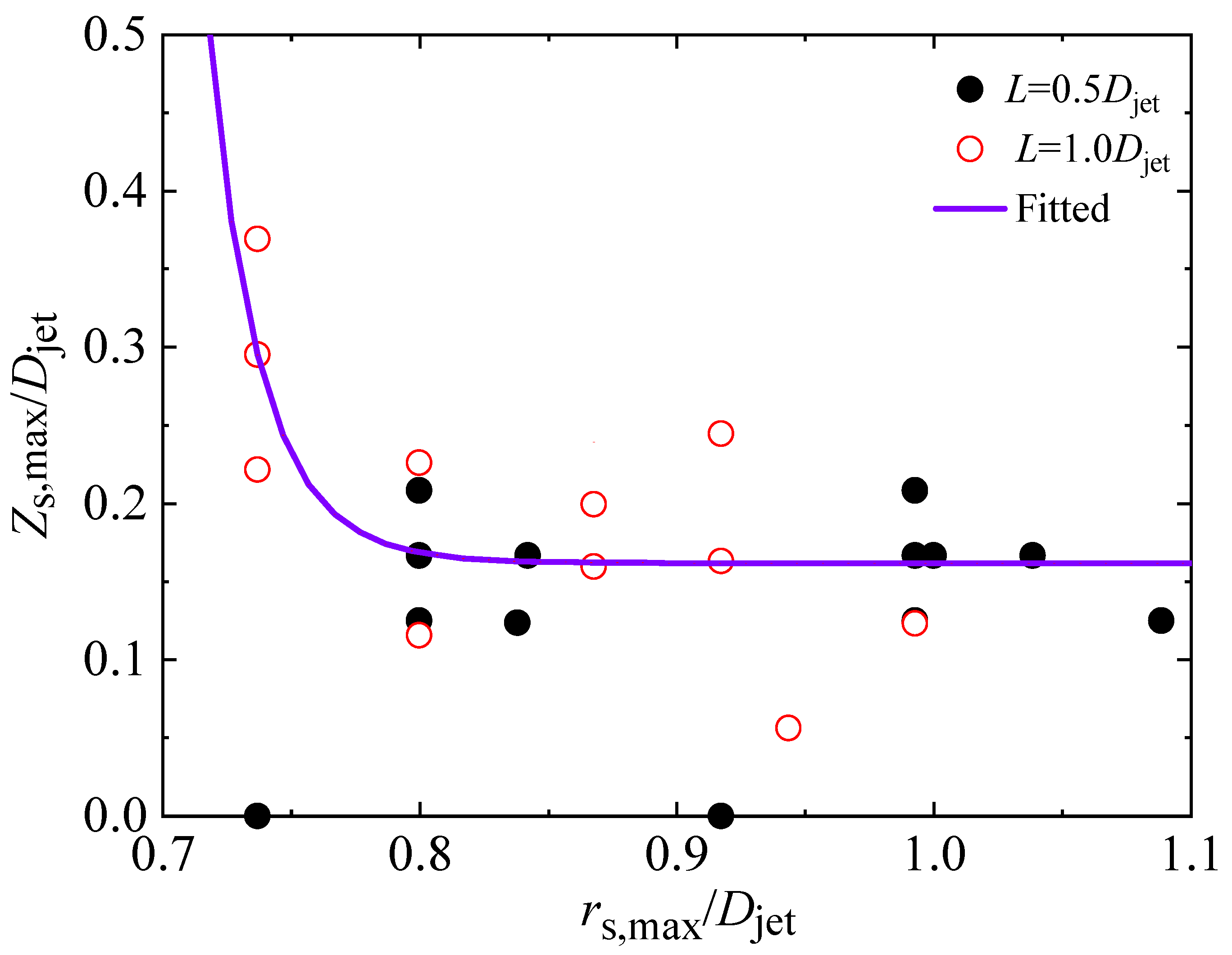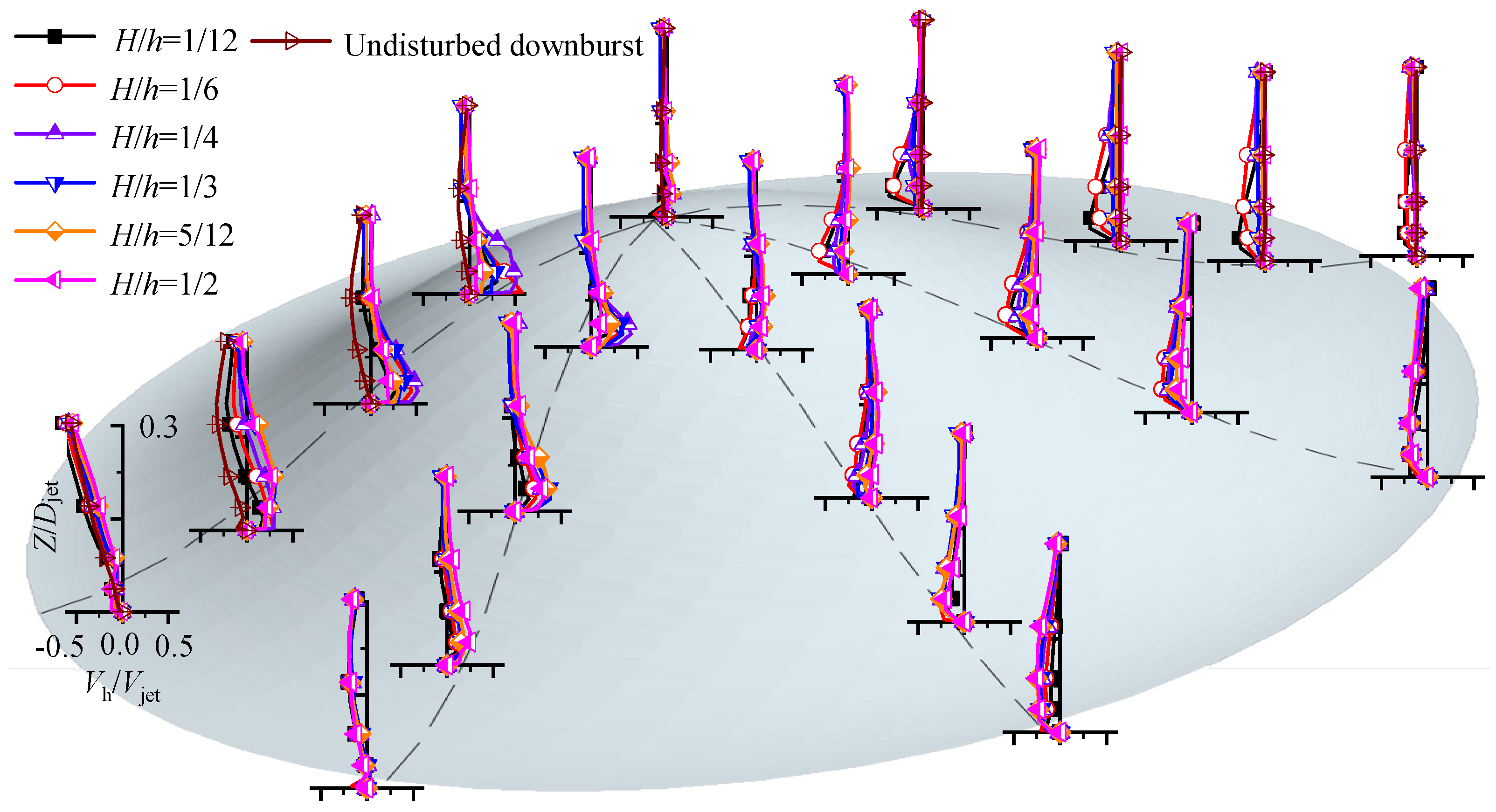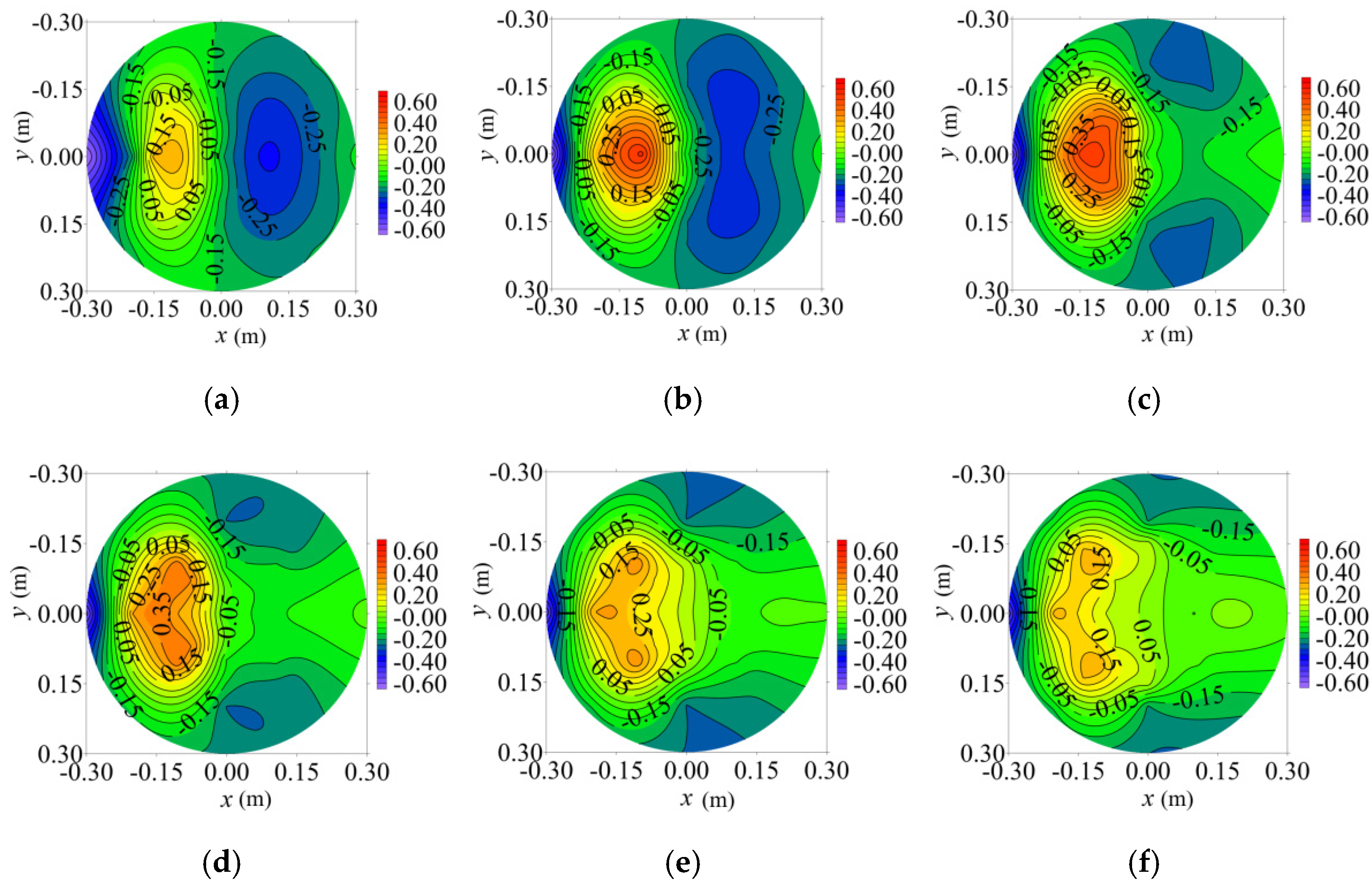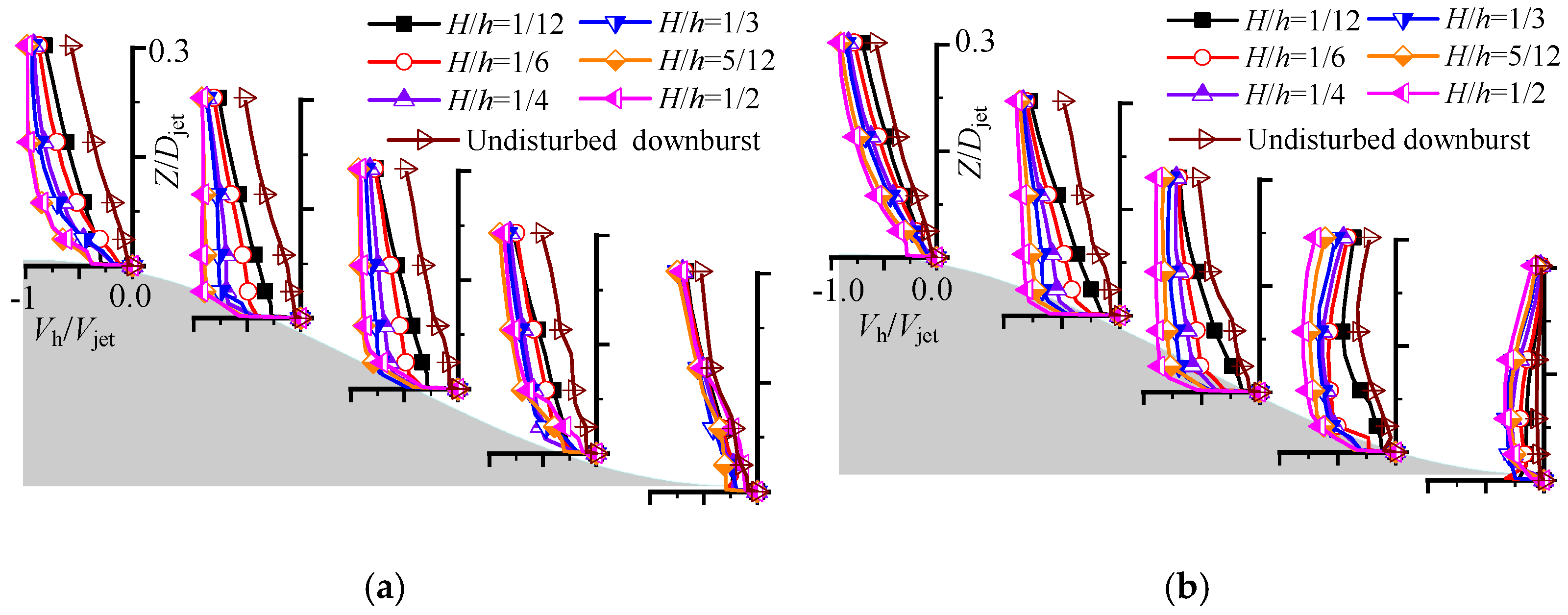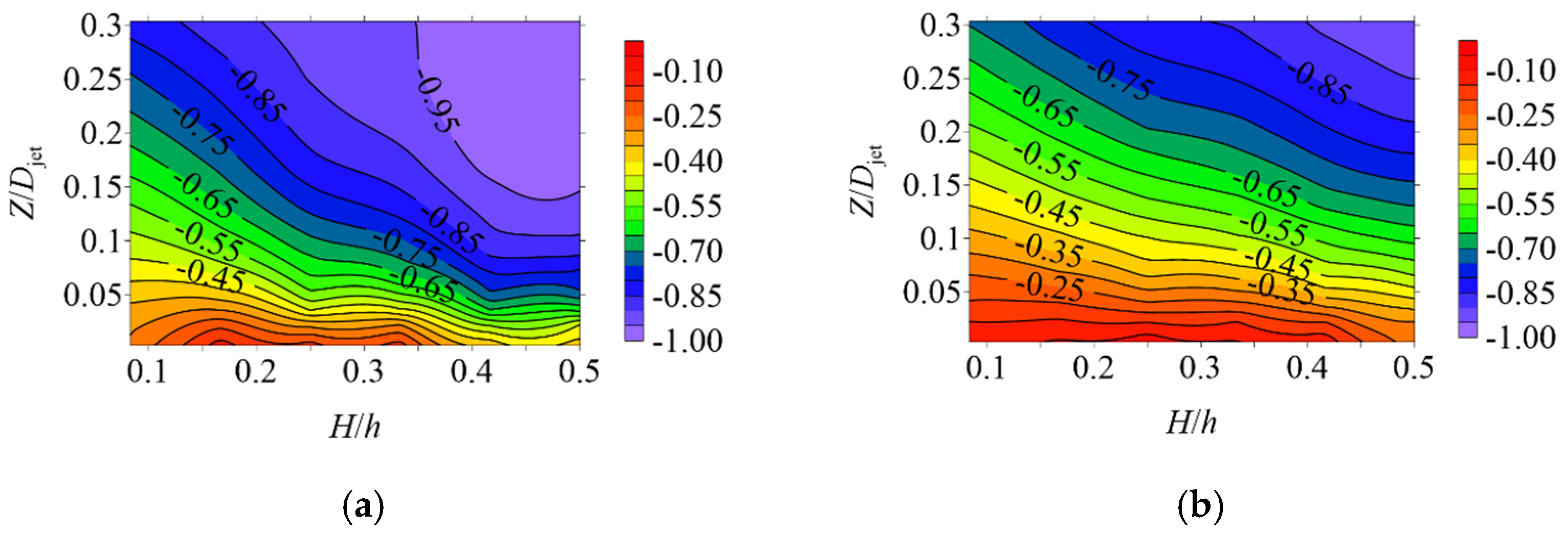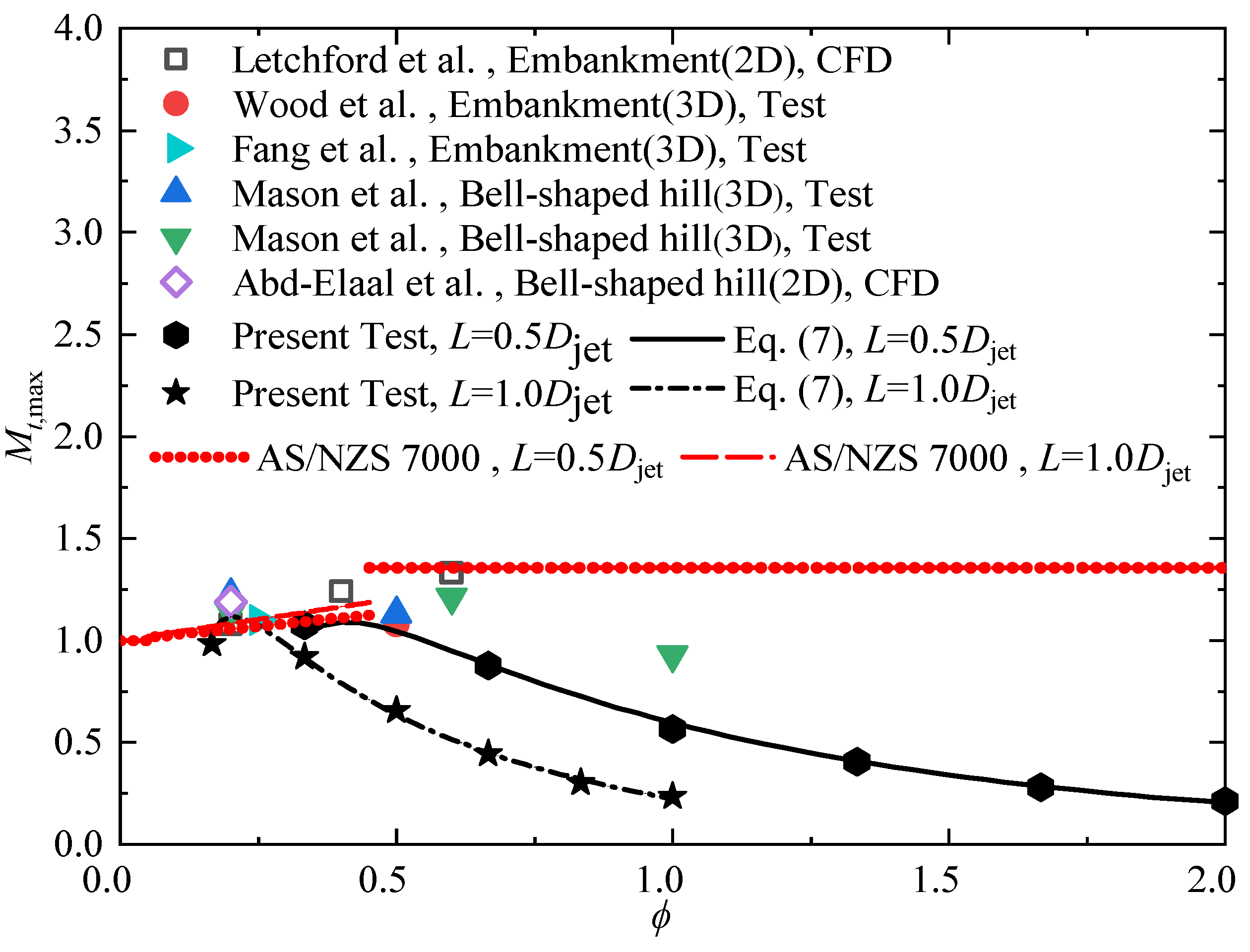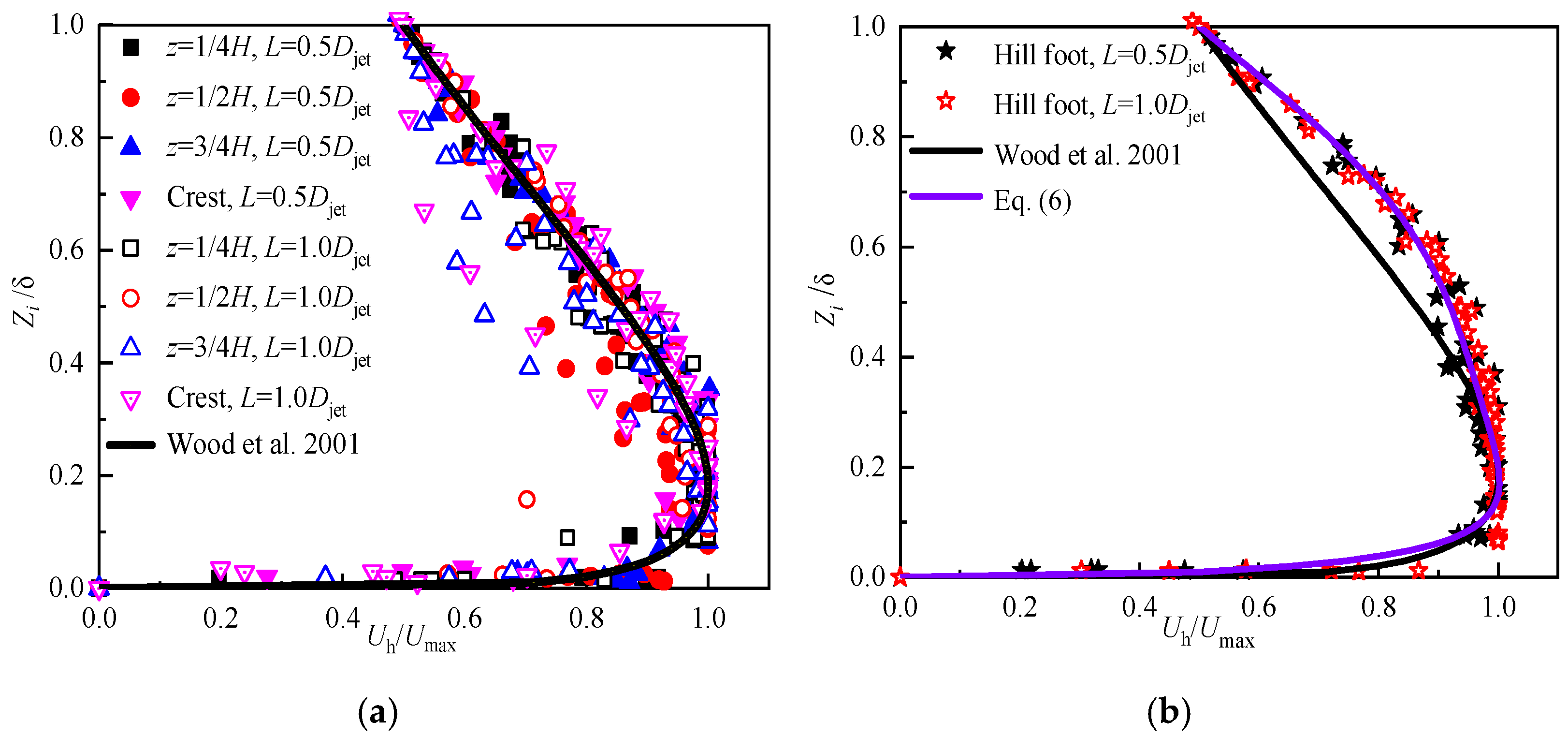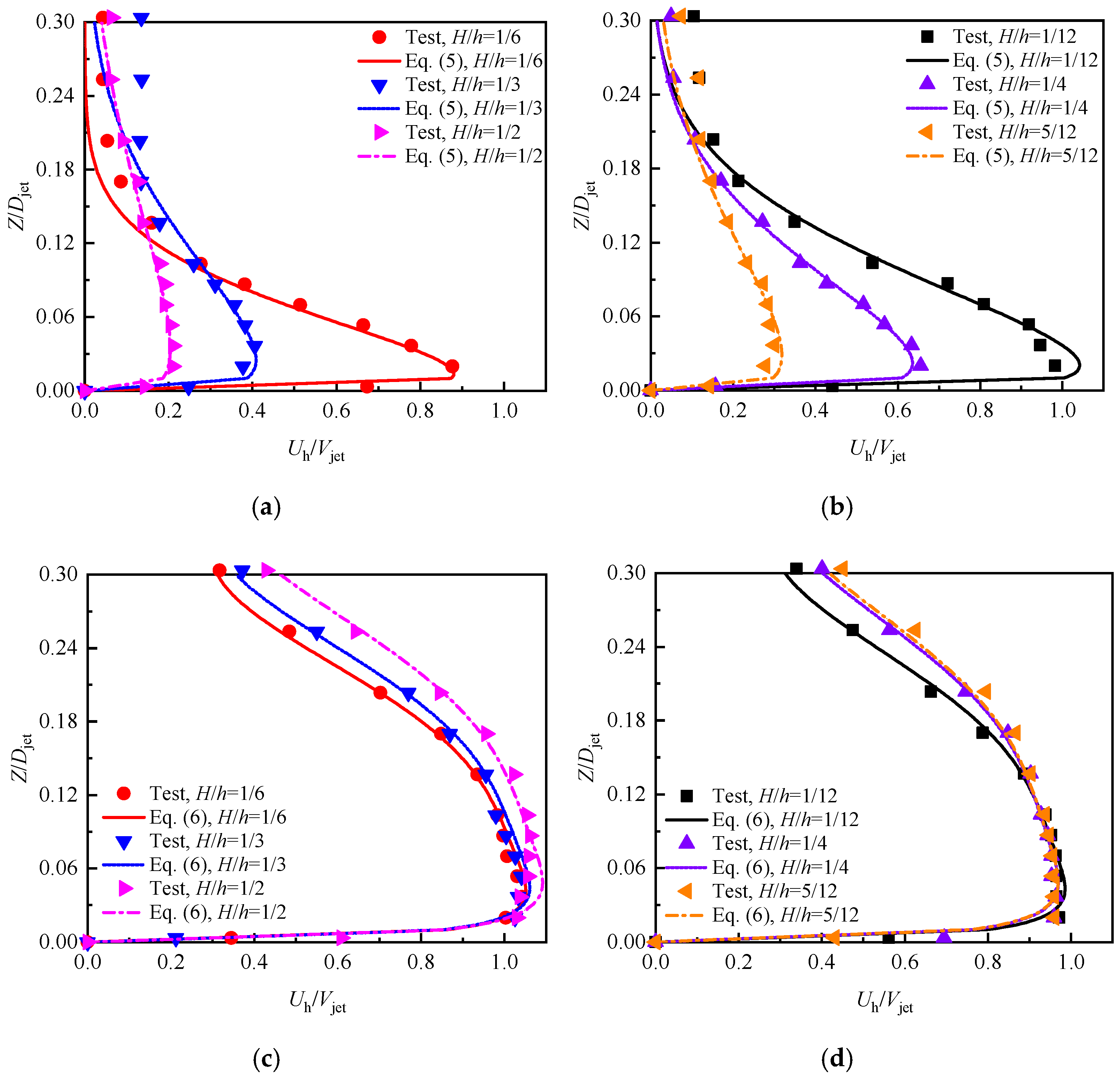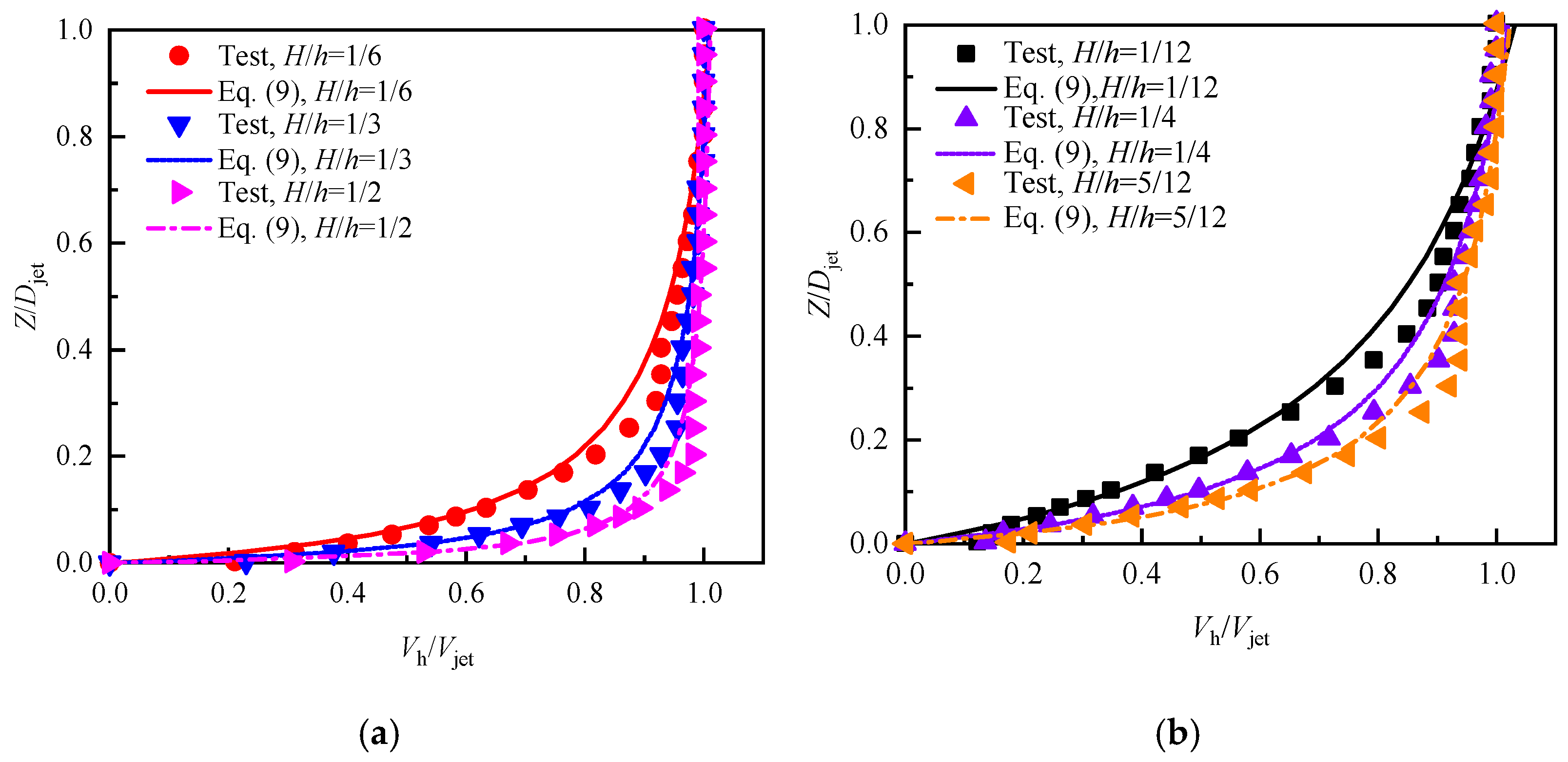To facilitate the design of structures erected on a hill, the resultant horizontal wind velocity,
U, as a function of
Z, is herein utilized for the analysis of the wind field. To characterize the speed-up phenomenon, the topographic multiplier for the maximum velocity amplification [
9,
10],
Mt,max, is utilized herein, in the form of
where the subscripts “topography” and “flat” represent the hilly terrain and the flat surface, respectively. The test results for the downburst wind flow over a flat surface without vegetation (undisturbed downburst, see
Figure 7) show that the maximum
Uflat is about 1.0
Vjet, which is similar to the findings of previous studies [
24,
25,
26,
27,
28]. The
Mt,max values greater than 1.0 indicate a strong horizontal wind occurring at that location with an intensity greater than the maximum found during an undisturbed downburst. Note that the traditional speed-up ratio, which is defined as the ratio of the wind velocity of a hilly terrain-disturbed atmospheric boundary layer (ABL) wind to that of an undisturbed ABL wind at the same height, cannot account for the speed-up of a downburst wind flow over hilly terrains, because the wind profiles of the undisturbed downburst wind vary with the distance from the stagnation point, in contrast to the invariant wind profile in the undisturbed ABL wind.
3.1. Horizontal Wind Velocity
For illustration, the downburst wind flows over the hill models with
L = 0.5
Djet and
rh = 1.0
Djet are first discussed.
Figure 7,
Figure 8 and
Figure 9 show the profiles of the horizontal velocity at different measuring locations. For the same location, the corresponding profiles in the undisturbed downburst wind field where the wall jet thickness
δ is about 0.15
Djet are also depicted in the figures. It is evident that the horizontal wind velocity varies with the relative height from the ground/hill surface. For convenience, we herein define “the global maximum” as the highest value for the entire wind field over the hill, and “the maximum” as the highest value for the same measuring location simultaneously measured at the different relative heights from the hill surface.
Regarding the horizontal wind on the
x-axis ridge, as shown in
Figure 7, it was found that the effects of the hill with a low height (
H/
h = 1/12) were relatively small in terms of the shape of the wind profile, as well as the location where the maximum horizontal wind velocity occurred (around 1.0
Djet). The predominant factor in determining the variation in the wind profile was the distance from the stagnation point. However, provided
H/
h > 1/12, the increase in
H/
h was found to reduce the intensity of the horizontal wind in general. It was also observed that the near-ground maximum horizontal wind velocity decreased correspondingly with the increase in the hill height. In the cases of
H/
h > 1/3, the wind velocities measured at the crest were even lower than those measured near the windward hill foot. This may be attributed to the blockage effect caused by the hill becoming increasingly significant as the height of the hill increased, weakening the intensity of the downburst wind flow over the crest. The speed-up phenomenon on the
x-axis ridge was only observed in the case of the hill with low elevation (
H/
h = 1/12), and occurred near the crest of hill, with a corresponding
Mt,max of 1.07
Vjet. Furthermore, it was found that the horizontal wind velocities measured on the windward side were generally greater than those measured on the leeward part.
The wind profiles on the
y-axis ridge are shown in
Figure 8. At the hill foot with a radial distance of roughly
r = 1.12
Djet, the wind intensity became relatively stronger. The maximum wind velocity at the hill foot was a little greater than the impinging jet velocity. However, regardless of the hill height, the wind profiles measured at the hill foot were generally similar, which implies that the hill height had a negligible effect at this location. For the hills with
H/
h > 1/6, it was found that the horizontal wind velocity was significantly decreased along the ridge, implying that the blockage effect was pronounced. Furthermore, corresponding with the increase in the hill height, the maximum wind velocity decreased. If
H/
h ≤ 1/6, the speed-up phenomenon could be observed along the whole ridge, and the maximum topographic multiplier was found at
z =
H/4 with a value of 1.08
Vjet.
In
Figure 9, the profiles of the horizontal wind velocity on the 45°-ray ridge (leeward side), as well as that on the 135°-axis ridge (windward side), are depicted. Generally, the wind velocities on the 135°-axis ridge were greater than those on the 45°-ray ridge. The profiles of horizontal wind velocity near the windward hill foot were similar, showing a negligible effect of hill height at that site. In addition, the corresponding wall jet thickness at that site was about 0.26
Djet, which is greater than that recorded during an undisturbed downburst wind (0.15
Djet), indicating an increased wind intensity. In contrast, the wind profiles along the 45°-ray ridge, whether recorded at the hill foot or at the crest, were influenced by the hill height, which indicates that the blockage effect on the leeward wind field was relatively significant.
The contour maps of
Mt,max are depicted in
Figure 10 and show the changes in wind intensity. As the hill height increases, the area of the speed-up region becomes increasingly small and the center of the region gradually moves to the windward hill foot lying on the 135° ray. In the cases of high hills, it was found that the speed-up regions when
Mt,max ≥ 1 were mainly located at the two sides of the hill. This again indicates that the downburst-induced near-ground strong airflow would be blocked if the hill is sufficiently high, and behaves like a flow around the hill body. In general, provided a high hill, the maximum horizontal wind velocity recorded for the crest was lower than that found at the hill foot, as shown in
Figure 10. For a hill with a low height, e.g., the case of
H =
h/12, in which the near-ground wind is capable of climbing over the hill, the speed-up region comprised a relatively larger area in the vicinity of the crest. These findings are also corroborated by the distribution of the wind velocity vector over the hill (see
Figure 11), where the arrows represent the directions and the magnitudes of the horizontal wind velocities. This flowing-around phenomenon was not observed in the previous studies using 2D hill models.
Figure 12 and
Figure 13 show the wind profiles when the hill models were placed at
rh = 0.8
Djet and
rh = 1.2
Djet. The variation in the wind field was similar to the foregoing findings in the case of
rh = 1.0
Djet. That is, the profiles for the hill models at these three hill positions show that the speed-up regions were mainly located in the vicinity of the edge on the windward side, indicating that more attention should be paid to wind velocity in this region. In addition, provided 0.8
Djet ≤
rh ≤ 1.2
Djet, the location of the hill model had insignificant effects on the magnitude of the wind profile near the hill foot. This lack of impact of the hill position is consistent with the findings of work by Mason et al. [
9,
10]. Generally, the wind profiles in the vicinity of the crest, as well as those on the leeward side, were relatively more susceptible to the hill height.
It is worth noting that in the cases surveyed, most of the profiles of the horizontal wind velocity have similar shapes to the downburst profile proposed by Wood et al. [
8], i.e., correspondingly with the increase in the relative height from the ground/surface, the velocity increases almost linearly, then rapidly decreases after reaching a peak. Comparatively, the vertical profile of the horizontal wind in the ABL wind (ABL wind profile) usually exhibits an exponential/logarithmic shape. In the cases of high hills, it was found that the shape of the wind profile at the windward side of the
x-axis ridge changed from a shape similar to an ABL wind profile to a shape more characteristic of a downburst profile. This phenomenon can be also observed in other cases, e.g.,
L = 1.0
Djet, as shown in
Figure 14,
Figure 15 and
Figure 16. Furthermore, the similarity to the ABL wind profile was usually but not always observed when
r/
Djet was around 0.5, and occasionally when
r/
Djet > 1.0 for high hills (
H/
h > 1/6).
Figure 17 shows the contour maps of the global maximum horizontal velocity, where the conditions under which the speed-up phenomenon occurred can be clearly identified. In the figure, the abscissa represents the hill position, and the ordinate is the ratio of hill height to jet height. The results show that the maximum horizontal velocity occurred when
rh was around 1.0
Djet. In the cases of the hills with
L = 0.5
Djet, it was found that a lower hill commonly resulted in a higher wind speed. However, in the case of the hill models with
L = 1.0
Djet, the maximum of
Mt,max was found to be 1.12 when
H/
h = 5/12.
In order to further investigate where a speed-up wind would occur on the hilly terrain, a relative altitude, denoted as
Zs, was employed. The relative altitude was designated as the relative height from the hill surface to
Z0, the mean altitude of the hilly terrain in the stagnation region, which may be expressed as
Zs=
z −
Z0. For each hill model, the maximum for the relative altitudes in the speed-up region, denoted as
Zs,max, was identified and associated with a corresponding radial distance of
rs,max from the stagnation point.
Figure 18 shows
Zs,max versus
rs,max. It was found that the average of
Zs,max was about 0.166
Djet (1.1
δ). This indicates that the speed-up would occur at the site with a relative altitude of around/below 0.166
Djet, resulting in a more severe downburst wind.
3.2. Vertical Wind Velocity
For illustration,
Figure 19 shows the corresponding profiles obtained experimentally for vertical wind velocity for the hill models with
L = 0.5
Djet and
rh = 1.0
Djet. In the figure, a negative value indicates a downward flow. It was found that the vertical wind velocities were lower than the horizontal wind velocities in general, and the global maximum of the former was less than 0.5
Vjet, except for the results measured at the hill foot lying on the
x-axis ridge. Focusing on the
x-axis ridge, the profile of vertical wind velocity varied with the altitude of the measuring site. On the windward part, the variation in wind direction with the relative height from the surface of the hill, identified in the same profile, indicates the occurrence of circulation on the ridge. This might be attributed to the flow hitting the hill surface and being forced into an upward flow to ascend the hill. In addition, it was found that the position of the circulation on the windward ridge gradually moved toward the hill foot, as the hill height increased. On the leeward part, a downward flow was observed.
Considering the 135°-ray ridge (windward), the profiles also show the occurrence of circulation on the ridge, which was relatively weaker compared to that on the x-axis ridge. In addition, the weak vertical wind found at the hill foot implies a flowing-over horizontal wind at that place. For the sites located at the y-axis and 45°-ray ridges, the wind profiles also showed a downward flow. Moreover, the vertical winds on the 135°-ray, y-axis and 45°-ray ridges were relatively weaker, compared to that found on the x-axis ridge.
Figure 20 shows the contour maps of the maximum vertical wind velocity. It was observed that both the global maximum vertical wind velocities corresponding to the upward airflow and those corresponding to the downward airflow initially increased with the increase in hill height before reaching a peak value, then decreasing. The peak value for the upward airflow was 0.5
Vjet (
H/
h = 1/4), whereas that for the downward flow was 0.65
Vjet (
H/
h = 1/6). Regarding the downward wind, it was found that the global maximum typically occurred at the leeward part of the
x-axis ridge if
H/
h ≤ 1/6, and at the hill foot of the
y-axis ridge if
H/
h > 1/6. With regards to the upward wind, the global maximum appeared at the windward
x-axis ridge if
H/
h ≤ 1/4, and at the two sides of the hill if
H/
h > 1/4. These findings again highlight that if the hill is sufficiently high, a circumfluent flow occurs on the sides of the hill.
To clarify the impact of the hill position on the maximum vertical wind velocity,
Figure 21 illustrates the corresponding contour maps for a typical hill model (
L = 0.5
Djet and
H/
h = 0.25) placed at
rh = 0.8
Djet,
rh = 1.0
Djet, and
rh = 1.2
Djet, respectively. These locations of the hill models are around where the strongest near-ground horizontal wind would be observed in a corresponding undisturbed downburst. The three subplots show a similar phenomenon; that is, the upward airflow occurs on the windward side and the downward airflow mainly occurs on leeward side. In addition, correspondingly with the increase in the horizontal distance from the downburst, the vertical wind velocity of the upward flow increased, whereas that of the downward flow decreased. Furthermore, the strong upward flow mainly appeared around the
x-axis ridge, whereas the strong downward flow appeared at the hill foot of the
y-axis ridges.
Though the foregoing analyses show that a significant vertical wind field was observed when the hill model was placed in the strong horizontal wind region, it is a priori true that the vertical wind field above the hill would be much stronger when the hill model is placed in the stagnation region.
Figure 22 shows the profiles of vertical wind velocity when the hill models were located at
rh = 0.0
Djet, namely directly below the impinging jet. The maximum among the measured vertical wind velocities at the crest was about 1.0
Vjet. Comparison of the results with the wind profiles at the same locations in the downburst over a flat surface shows a similar curve shape. Generally, the vertical wind velocity at a site that was farther from the crest/stagnation point was lower. In the stagnation region, the vertical wind velocities increased monotonically with the increase in the relative height from the hill surface, as well as the increase in the hill height, which implies that the variation in wind velocity corresponding to height can be mainly attributed to the vertical distance from the nozzle; that is, a shorter vertical distance results in a higher vertical wind velocity.
Figure 23 shows the contour maps of the vertical velocity at the crest. Note that the hill model in
Figure 23a has a steeper slope than the hill model in
Figure 23b, but the two hill models have the same hill height. It was found that a steeper slope led to a greater gradient in the vertical velocity.
3.3. Comparison with the Results of Previous Studies
Since the results of previous studies mainly pertain to horizontal wind dynamics, this section focuses only on the comparison of the horizontal wind velocities. Regarding the hill models located in the strong horizontal wind region, the maximum
Mt,max for each model and hill position are summarized in
Table 4. The maximum
Mt,max shown in the table could aid in determining downburst wind loads and inform a simplified design of structures subjected to such conditions. It is evident that both the maximum
Mt,max obtained at the crest and that observed at the hill foot decreased with the increase in the hill height. In addition, the maximums of
Mt,max obtained elsewhere were relatively large, in the range of 1.03 to 1.12. Note that the work by Shen et al. [
22], utilizing a hill model with a similar shape to those employed in the present study, found that the maximum speed-up ratio during an ABL wind flow over a 3D hill was about 1.34. It can be thus concluded that the speed-up effect found during a downburst wind is commonly smaller than occurs during an ABL wind, provided the hill terrain is the same. This is consistent with the findings of previous studies [
6,
7].
The Australian and New Zealand standard entitled “Overhead line design—detailed procedures” (AS/NZS 7000: 2010) [
29] specifies that the topographical multiplier
Mt,downdraft for downbursts can be computed using the formula
where
Mt,synoptic is the topographical multiplier for synoptic winds and is defined in the code entitled “Structural design actions-Part 2: wind actions” (AS/NZS 1170.2: 2011) [
30]. For the present study,
Mt,synoptic =
Mh, where
Mh is the hill shape multiplier specified in AS/NZS 1170.2: 2011 [
30] and can be computed using the formula
where
L1 and
L2 = 4
L1 are the length scales used to determine the vertical and the horizontal variations in
Mh, and
L1 can be taken as the greater of 0.36
Lu or 0.4
H.
For the
Mt,max at the crest,
Figure 24 shows the results from the previous research, the curves defined using Equation (3), and the experimental results from the present study. It can be observed that in the case of a small slope (
ϕ ≤ 0.45) the results show good agreement. With the increase in the slope, the
Mt,max at the crest decreases, whereas AS/NZS 7000: 2010 [
29] merely provides a constant topographic multiplier, which results in an excessively conservative design in general. There is a need for formulas that enable a relatively accurate prediction of
Mt,max in order to inform a rational design of structures. The discrepancy is largely attributable to the confined nature of the downburst. Moreover, the topographic multiplier defined for an ABL wind, e.g., Equation (4), is not suitable for a downburst wind, particularly in the case of high hills. Regarding the downburst wind, it is worth noting that a relatively higher
Mt,max than those illustrated in
Figure 24 probably occurs at other locations, as shown in
Table 4.
